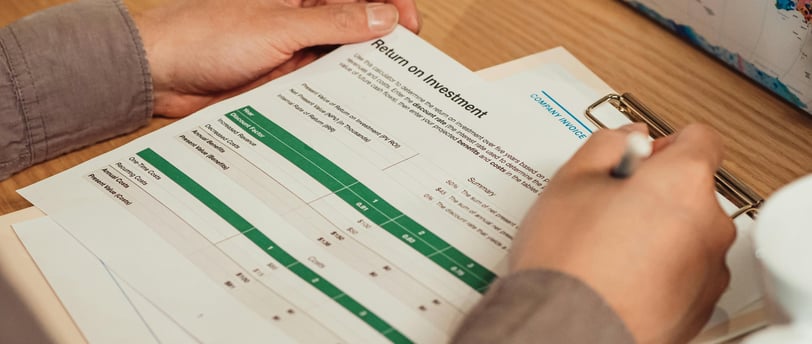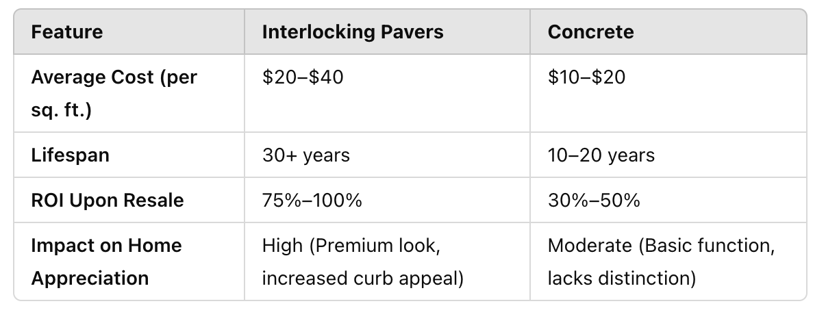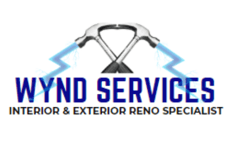Return on Investment: Interlocking Pavers vs. Concrete in Canada
interlocking pavers and concrete compare in terms of ROI, curb appeal, and long-term property appreciation.
3/26/20252 min read


When upgrading outdoor spaces like driveways, patios, and walkways, homeowners often compare interlocking pavers and concrete. While upfront costs and maintenance are important factors, the real financial impact lies in return on investment (ROI) and home appreciation. In Canada’s fluctuating real estate market, choosing the right material can significantly affect property value and resale potential. This article focuses on how interlocking pavers and concrete compare in terms of ROI, curb appeal, and long-term property appreciation.
1. The Impact on Property Value
A well-maintained outdoor space enhances curb appeal, making a home more attractive to potential buyers. Studies show that a well-designed landscape can increase home value by 10%–15%. The quality of outdoor materials plays a significant role in this appreciation.
Interlocking Pavers:
Creates a high-end, custom look that buyers find appealing
Adds to the overall aesthetic and perceived value of the home
Can increase home resale value by 8%–12%, leading to higher asking prices
Concrete:
Provides a basic, functional surface but lacks visual appeal
More prone to wear, staining, and cracking over time
Can increase home resale value by only 3%–5%, offering lower returns
2. Return on Investment (ROI) Breakdown
When considering any home improvement, homeowners want to know how much of their investment they will recoup upon selling. The ROI for interlocking pavers is significantly higher than for concrete.
3. Long-Term Savings & Hidden Costs
Beyond ROI, homeowners should consider long-term savings and costs. While concrete is cheaper upfront, it has a higher likelihood of cracking and needing repairs, reducing its overall value. On the other hand, interlocking pavers require minimal maintenance and allow for easy replacement of individual pavers, keeping them looking new for decades.
Interlocking Pavers:
Maintenance costs are low; individual pavers can be replaced without affecting the whole area
Long-lasting, reducing the need for reinstallation
Concrete:
Cracking and wear require expensive repairs or full resurfacing
May need complete replacement within 15–20 years
4. Market Trends: Buyer Preferences in Canada
Canadian homebuyers are increasingly valuing durable, low-maintenance, and visually appealing outdoor spaces. In competitive markets like Toronto, Vancouver, and Montreal, homes with high-quality outdoor finishes like interlocking pavers sell faster and at higher prices.
Homes with interlocking paver driveways and patios tend to be listed at premium prices because of their long-term durability and aesthetic appeal.
Homes with basic concrete driveways may not stand out in the market, making it harder to justify a higher asking price.
Which Option Yields Better Financial Gains?
From a financial perspective, interlocking pavers are the superior investment for homeowners looking to maximize ROI and home appreciation. While concrete is initially more affordable, it does not contribute as significantly to property value and can require costly repairs over time. If increasing resale value and long-term financial returns are priorities, interlocking pavers offer the best return on investment.
For Canadian homeowners planning outdoor renovations, interlocking pavers are not just a design choice—they are a strategic financial investment that enhances both curb appeal and long-term property value.
📞 Ready to upgrade your outdoor space? Contact us today for a free consultation!


Contact Us
Quotes
contact@wyndservices.com
647.270.8131
© 2025. All rights reserved.


